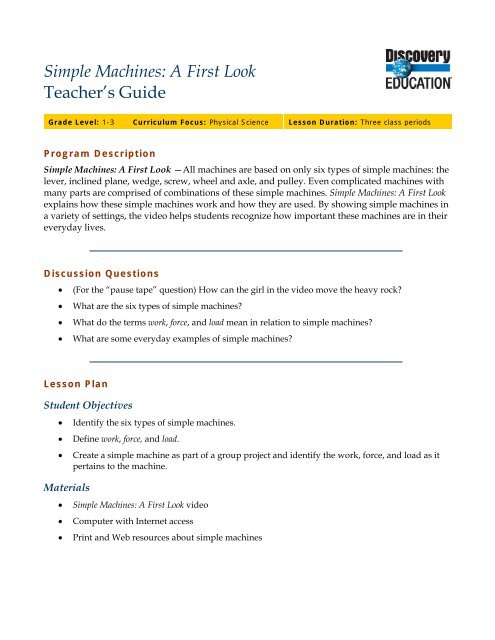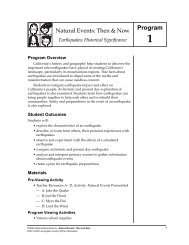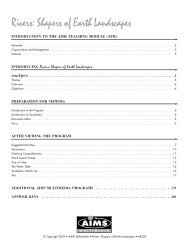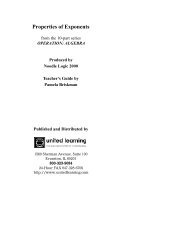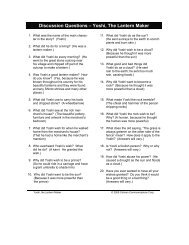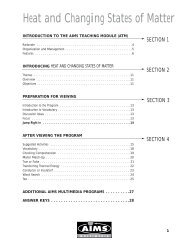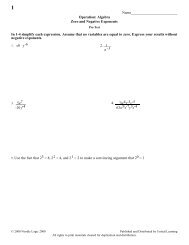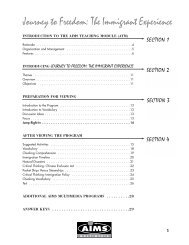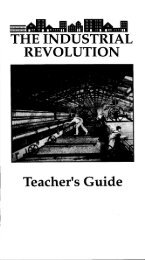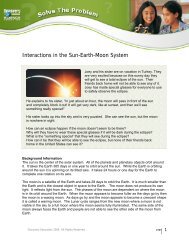Simple Machines - Discovery Education
Simple Machines - Discovery Education
Simple Machines - Discovery Education
You also want an ePaper? Increase the reach of your titles
YUMPU automatically turns print PDFs into web optimized ePapers that Google loves.
<strong>Simple</strong> <strong>Machines</strong>: A First LookTeacher’s Guide 3http://home.earthlink.net/~kandyhig/sm/index.htm6. When students have completed their initial research, ask each team to build the type of simplemachine team members have researched. Ask students to use available classroom resources,such as pencils, rubber bands, wood blocks, wheels, and so on. The completed projects shouldanswer the following questions: What work can be accomplished using this machine? Whattype of force is needed to operate this machine? What is the load?7. Have each team demonstrate its simple machine in front of the class; define the work, force, andload as it pertains to the machine; and answer any questions.AssessmentUse the following three-point rubric to evaluate students’ work during this lesson.Vocabulary• 3 points: Students were highly engaged in class discussions; produced a complete project,including all of the requested information; accurately defined the three key terms in theirclassroom demonstration.• 2 points: Students participated in class discussions; produced an adequate project, includingmost of the requested information; satisfactorily defined two of the three key terms in theirclassroom demonstration.• 1 point: Students participated minimally in class discussions; created an incomplete projectwith little or none of the requested information; were not able to define any of the three keyterms in their classroom demonstration.forceDefinition: Push or pullContext: The type of force needed to operate a pulley is a pulling motion.fulcrumDefinition: The point on which a lever stick pivotsContext: The longer the distance a force is from a fulcrum, the less effort it takes to move a load.inclined planeDefinition: A simple machine consisting of a flat surface with one end higher than the otherContext: A playground slide is an example of an inclined plane.leverDefinition: A simple machine consisting of a bar, or lever stick, that pivots on a point called thefulcrumContext: A lever can help you lift objects that would be too heavy to lift on your own.Published by <strong>Discovery</strong> <strong>Education</strong>. © 2005. All rights reserved.
<strong>Simple</strong> <strong>Machines</strong>: A First LookTeacher’s Guide 4loadDefinition: The object being lifted or moved by a machineContext: People use simple machines to move loads from one place to another.pulleyDefinition: A simple machine consisting of a grooved wheel and a ropeContext: A moveable pulley moves as the load moves, while a fixed pulley stays in place.screwDefinition: A simple machine consisting of an inclined plane wrapped around a postContext: A road that winds around a mountain is an example of an inclined plane and a screw.simple machineDefinition: A machine with few if any moving partsContext: Construction vehicles are made up of combinations of simple machines.wedgeDefinition: A simple machine used to cut or split an objectContext: A wedge consists of two inclined planes put together.wheel and axleDefinition: A simple machine consisting of a center rod attached to a wheelContext: A wagon uses wheels and axles to move objects from one place to another.workDefinition: The moving of an object over a distanceContext: The work of an inclined plane is to move an object higher or lower across a certaindistance.Academic StandardsNational Academy of SciencesThe National Academy of Sciences provides guidelines for teaching science in grades K–12 topromote scientific literacy. To view the standards, visit this Web site:http://books.nap.edu/html/nses/html/overview.html#content.This lesson plan addresses the following national standards:• Physical Science: Properties of objects and materials; Position and motion of objects• Science and Technology: Abilities of technological design; Understanding about science andtechnologyPublished by <strong>Discovery</strong> <strong>Education</strong>. © 2005. All rights reserved.
<strong>Simple</strong> <strong>Machines</strong>: A First LookTeacher’s Guide 5Mid-continent Research for <strong>Education</strong> and Learning (McREL)McREL’s Content Knowledge: A Compendium of Standards and Benchmarks for K–12 <strong>Education</strong>addresses 14 content areas. To view the standards and benchmarks, visithttp://www.mcrel.org/compendium/browse.asp.This lesson plan addresses the following national standards:• Science—Physical Sciences: Understands forces and motion• Technology: Understands the nature of technological design; Understands the nature anduses of different forms of technology• Language Arts—Viewing: Uses viewing skills and strategies to understand and interpretvisual mediaSupport MaterialsDevelop custom worksheets, educational puzzles, online quizzes, and more with the free teaching toolsoffered on the <strong>Discovery</strong>School.com Web site. Create and print support materials, or save them to aCustom Classroom account for future use. To learn more, visithttp://school.discovery.com/teachingtools/teachingtools.html.CreditRobyn Kurth, freelance writerPublished by <strong>Discovery</strong> <strong>Education</strong>. © 2005. All rights reserved.


